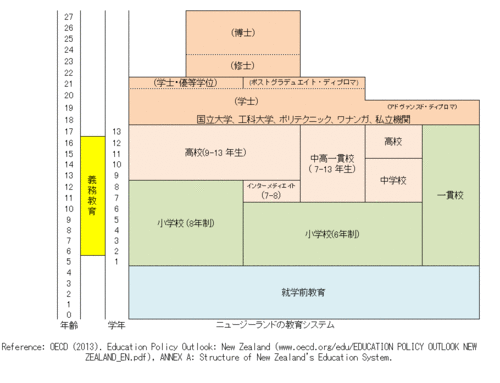| 世界の保育・幼児教育の状況を理解するために、各国の背景事情の把握は欠かせません。ここでは、その国の人口規模・教育投資などの基礎的な情報から教育制度に至るまでを、就学前の時期を中心にご紹介します。世界の保育・幼児教育に関心のある読者の皆さまの参考になれば幸いです。 |
1. 首都:ウェリントン
2. 人口:4 596 000 (2015)
3. 公用語:英語、マオリ語、ニュージーランド手話
4. 通貨:ニュージーランド・ドル (NZD)
5. 教育および保育の制度
- 学制:就学前教育(0歳から5歳)、初等教育/インターメディエイト・スクール(5歳から12歳、11歳から12歳はインターメディエイト)、中等教育(13歳から17歳)、高等教育(16歳から)
- 管轄省庁:教育省
- 義務教育:6歳から16歳
- 就学前教育は、教師主導のサービスと親主導のサービスの2つに大きく分けられる。前者は幼稚園、保育園など、後者は、マオリ語での教育を主とするコハンガレオ、プレイセンター、プレイグループなどである。
- 3歳:87% (2012)
- 4歳:94% (2012)
- 5歳:99% (2012)
- 6歳:100% (2012)
- 就学前:0.5% (2011)
- 初等・中等・高等教育以外の中等後教育:5.0% (2011)
- 全教育段階:7.4% (2011)
- 初等教育:データなし
- 就学前:7 (2012)
- 初等教育:16 (2012)
- PISA 2012: 数学-22、読解-13、科学-18
- TIMSS 2011(4年生): 数学-31、科学-31

※画像をクリックすると拡大表示されます。
-
Reference 参考資料
- 2. Population Division, United Nations. World Population Prospects: The 2012 Revision.
http://esa.un.org/unpd/wpp/unpp/panel_population.htm. - 5. OECD (2013). EDUCATION POLICY OUTLOOK: NEW ZEALAND (www.oecd.org/edu/EDUCATION POLICY OUTLOOK NEW ZEALAND_EN.pdf), ANNEX A: STRUCTURE OF NEW ZEALAND'S EDUCATION SYSTEM.
- Ministry of Education. Choices in early childhood education.
http://www.minedu.govt.nz/Parents/EarlyYears/OtherInformationAndResources/Choices/WhatAreMyChoices.aspx. - 6. OECD (2014). Education at a Glance 2014: OECD Indicators, OECD Publishing.
http://dx.doi.org/10.1787/eag-2014-en. Table C2.1 Enrolment rates in early childhood and primary education, by age (2005, 2012). http://dx.doi.org/10.1787/888933118333. - 7. OECD (2014). Education at a Glance 2014: OECD Indicators, OECD Publishing.
http://dx.doi.org/10.1787/eag-2014-en. Table B4.1. Total public expenditure on education (2011). http://dx.doi.org/10.1787/888933117573. - 8. OECD (2014). Education at a Glance 2014: OECD Indicators, OECD Publishing.
http://dx.doi.org/10.1787/eag-2014-en. Table D2.1. Average class size, by type of institution and level of education (2012). http://dx.doi.org/10.1787/888933119682. - 9. OECD (2014). Education at a Glance 2014: OECD Indicators, OECD Publishing.
http://dx.doi.org/10.1787/eag-2014-en. Table D2.2. Ratio of students to teaching staff in educational institutions (2012). http://dx.doi.org/10.1787/888933119682. - 10. OECD (2013). PISA 2012 RESULTS IN FOCUS. Snapshot of performance in mathematics, reading and science. http://www.oecd.org/pisa/keyfindings/pisa-2012-results-snapshot-volume-I-ENG.pdf.
- Martin, M.O., Mullis, I.V.S., Foy, P., & Arora, A. (2012).The TIMSS 2011 International Results in Mathematics. Chestnut Hill, MA: TIMSS & PIRLS International Study Center, Boston College. http://timssandpirls.bc.edu/timss2011/downloads/T11_IR_M_Chapter1.pdf, p.40.
- Martin, M.O., Mullis, I.V.S., Foy, P., & Stanco, G.M. (2012). The TIMSS 2011 International Results in Science. Chestnut Hill, MA: TIMSS & PIRLS International Study Center, Boston College. http://timss.bc.edu/timss2011/downloads/T11_IR_S_Chapter1.pdf, p.38.














